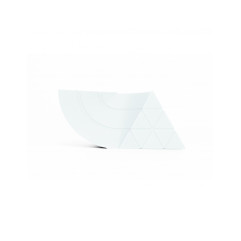TPU 93A White Flexible Filament for 3D Printers | Smartfil
TPU 93A White Flexible Filament for 3D Printers | Smartfil
750g
Te quedan 120€ para el envío gratis

24h Delivery

FREE for orders over 120€

Secure payment
Usually joint purchase

Información del producto
WHITE FLEXIBLE FILAMENT SPOOL FEATURES:
- Product name: SMARTFIL FLEX 93A
- Filament type: Flexible | TPU – Thermoplastic Elastomer
- Color: White (other colors available)
- Diameter: 1.75 mm / 2.85 mm
- Net weight: 330 g / 750 g (selectable)
- Gross weight: 450 g / 975 g (selectable)
- Recommended print settings:
- Print temperature: 220 – 230 °C
- Bed temperature: 0 – 60 °C
- Cooling fan: 60 – 80%
- Speed: 20 – 30 mm/s (up to 35 mm/s with direct drive)
- Layer height: ≥ 0.1 mm
- Nozzle: ≥ 0.2 mm (recommended: brass or steel)
- Flow rate: 100%
SMARTFIL® FLEX 93A is a technical flexible filament made of TPU (Thermoplastic Polyurethane) with a Shore A hardness of 93. Designed to print elastic, impact-absorbing, and deformation-resistant parts, this material is ideal for shock absorbers, bumpers, seals, technical footwear, protective cases, and more.
Unlike other flexible filaments on the market, SMARTFIL FLEX 93A is formulated for easy use on standard FDM 3D printers, avoiding jams and clogs. Its 93A hardness offers a perfect balance of flexibility, mechanical strength, and printability, making it ideal for both home and professional 3D printing.
KEY BENEFITS OF SMARTFIL® FLEX 93A
- High elasticity: elongation at break above 300%
- Excellent shock and vibration absorption
- Shore A 93A hardness: easier to print than softer TPUs (77A or 85A)
- No clogs: compatible with direct and Bowden extruders
- Strong layer and bed adhesion
- Compatible with most home 3D printers
WHY IS IT CALLED TPU?
TPU stands for Thermoplastic Polyurethane. It combines the elasticity of rubber with the processability of plastic. It can be recycled, molded, and extruded—perfect for 3D printing.
CHOOSING BETWEEN 77A, 85A, 93A AND 98A
| Shore A | Flexibility | Ease of printing | Applications |
|---|---|---|---|
| 77A | Very soft, like silicone | Difficult, direct drive only | Textiles, soft seals, synthetic leather |
| 85A | Quite soft | Moderate difficulty | Wearables, phone cases, protectors |
| 93A | Flexible and easy to handle | Easy, perfect for home printers | Cushioned parts, brackets, accessories |
| 98A | Semi-rigid | Very easy | Wheels, clips, semi-flexible gears |
MECHANICAL AND PHYSICAL PROPERTIES
| Property | Value | Unit | Standard |
|---|---|---|---|
| Tensile strength | 12.7 | MPa | ISO 527 |
| Tensile modulus | 2.7 | MPa | ISO 527 |
| Flexural strength | 33.6 | MPa | ISO 178 |
| Flexural modulus | 50.4 | MPa | ISO 178 |
| Elongation at break | 301.4 | % | ISO 527 |
| Charpy impact (unnotched) | 75.3 | kJ/m² | ISO 179 |
| Hardness | 93 | Shore A | ISO 7619-1 |
| Density | 1.21 | g/cm³ | ASTM D792 |
| VICAT B (50N 50°C/h) | 56 | °C | ISO 306 |
NOTE: Values are based on test specimens printed with 0.4 mm nozzle, 100% rectilinear infill, and 0.2 mm layer height. For more information, contact info@smartmaterials.com or visit www.smartmaterials3d.com
FLEXIBLE TPU 93A IN COMMON 3D PRINTERS
- Bambu Lab A1 Mini / P1S / X1C: ✅ Compatible (direct drive). Use 25 mm/s, enable pressure advance
- Prusa MK4 / MINI+: ✅ Compatible. Use textured PEI bed and slow speed
- Creality K1 Max / K1C: ⚠️ Only direct drive models. Bowden setups require careful tuning
- Anycubic Kobra 2 Max / Neo: ✅ Compatible with 0.4 mm nozzle. Low retraction and slow speed needed
- Elegoo Neptune 4: ⚠️ Best with direct drive. Use slow print speed (<20 mm/s), disable retraction, and enable slow outer wall
COMMON CHALLENGES WHEN PRINTING TPU 93A
- Clogging: TPU may buckle in Bowden extruders if the filament path isn't constrained
- Stringing: Can occur if fan is too low or nozzle too hot
- Retraction issues: Excessive retraction can jam the nozzle; use slow, short retractions
- Bed adhesion: Use a warm bed and textured surface like PEI or blue tape
TPU 93A PRINTING TIPS
- Use direct drive extruder for best control over soft filament
- Disable or minimize retraction: 0.5 mm and 15 mm/s is ideal
- Print slow: Maximum 30 mm/s for flexible materials
- Enable coasting to reduce nozzle pressure and oozing
- Disable combing in hollow parts to avoid internal stringing
- Drying not mandatory, but improves quality if filament absorbed moisture
Más productos de Smart Materials 3D






















